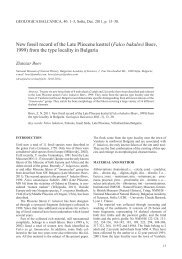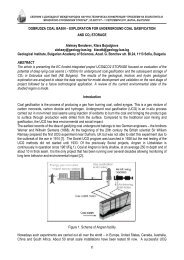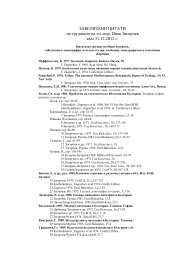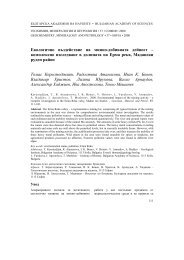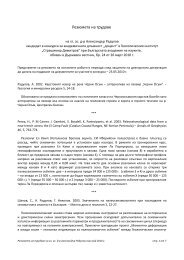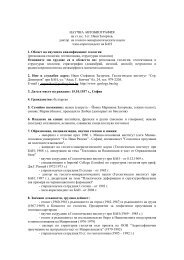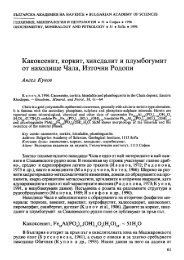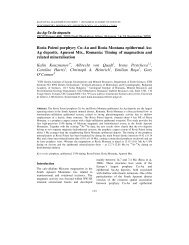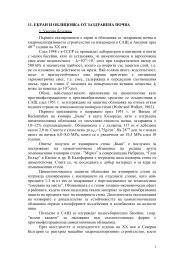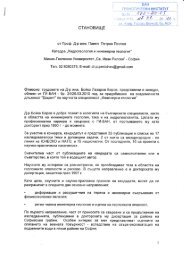2: Hydrothermal ore deposits related to post-orogenic extensional ...
2: Hydrothermal ore deposits related to post-orogenic extensional ...
2: Hydrothermal ore deposits related to post-orogenic extensional ...
You also want an ePaper? Increase the reach of your titles
YUMPU automatically turns print PDFs into web optimized ePapers that Google loves.
74<br />
Apart from its unusual structural setting and lack of<br />
obvious relationships with the local magmatism, the<br />
sediment-hosted mineralization exhibits many features<br />
that are typical of the adularia class of epithermal<br />
<strong>deposits</strong>, including banded veins of variably crystalline<br />
silica with adularia, bladed carbonates (occurring<br />
locally at Rosino, but commonly at Ada Tepe), and<br />
locally visible gold in some veins, giving rise <strong>to</strong><br />
bonanza grades of up <strong>to</strong> 50 <strong>to</strong> 60 g/t over 10 <strong>to</strong> 20<br />
m. The <strong>deposits</strong> are typically very base-metal-poor<br />
(Stremtsi, Ada Tepe), except for a small amount of<br />
galena, sphalerite and chalcopyrite at Rosino (Stama<strong>to</strong>va,<br />
1996; Marchev et al., 2003). Sedefche is another<br />
exception, having a higher content of base metals<br />
along with Pb–Ag–Sb sulphosalts and stibnite (Mladenova,<br />
1998). Visible Au has not been established,<br />
but Mladenova (1998) suggested that it was concentrated<br />
in the early pyrrhotite and arsenopyrite. These<br />
features (invisible gold, Sb mineralization and carbonate-rich<br />
host sediments) are very similar <strong>to</strong> <strong>ore</strong><br />
<strong>deposits</strong> described in southern Tuscany, in the peripheral<br />
zones of the active geothermal fields of Larderello,<br />
Monte Amiata and Laterra (Lattanzi, 1999 and<br />
references therein).<br />
Gold mineralization at Ada Tepe (Marchev et al.,<br />
2004b) and Stremtsi (Stama<strong>to</strong>va, 1996) consists<br />
mainly of electrum, associated with a small amount<br />
of pyrite or iron oxide (goethite). Traces of Au–Ag<br />
tellurides have been found in Ada Tepe. Electrum<br />
tends <strong>to</strong> occur on the margins of opaline quartz–<br />
adularia bands (in Ada Tepe) or in quartz–adularia<br />
aggregates and veinlets (at Stremtsi and Rosino).<br />
Unlike Ada Tepe, Au at Stremtsi shows highly variable<br />
composition and morphology. Gold in Rosino<br />
occurs as small intergrowths and inclusions along<br />
the grain boundaries of sulphides precipitated at the<br />
margins of thin (mm <strong>to</strong> cm) quartz–adularia–ankerite–<br />
siderite veinlets.<br />
Alteration at Ada Tepe and Stremtsi is represented<br />
by quartz, adularia, sericite, pyrite, chlorite, carbonates<br />
and clay minerals in variable proportions. Massive<br />
silicification is characteristic of the tabular body<br />
of Ada Tepe and the limes<strong>to</strong>ne of Sedefche, which is<br />
converted in<strong>to</strong> jasperoid quartz.<br />
Fluid inclusions have been studied only in the<br />
Rosino deposit (Nokov et al., 1992; Chris<strong>to</strong>va,<br />
1995, 1996) and at Surnak and Sinap (Chris<strong>to</strong>va,<br />
1995, 1996; Kunov et al., 1999). The homogenization<br />
P. Marchev et al. / Ore Geology Reviews 27 (2005) 53–89<br />
temperatures of fluid inclusions in quartz from Rosino<br />
are slightly lower than those in adularia (Table 5).<br />
Cryometric analyses in the adularia (Chris<strong>to</strong>va, 1995,<br />
1996) indicate low salinity with a variable component<br />
of Mg or Ca chloride. Mineralization at Sarnak and<br />
Sinap precipitated from very dilute Na–K–Cl solutions<br />
at low temperatures. Temperature and pressure<br />
conditions in the Ada Tepe and Sedefche <strong>deposits</strong><br />
have been roughly estimated on the basis of geological<br />
and mineralogical data, which indicate low temperatures<br />
and a shallow depth (b200 m) for the<br />
deposition of the bonanza Au bands at Ada Tepe. It<br />
probably resulted either from decompression, causing<br />
boiling and a temperature drop, or from mixing with<br />
cooler meteoric groundwater (Marchev et al., 2004b).<br />
Mineralization at Sedefche seems <strong>to</strong> have occurred at<br />
slightly higher temperatures.<br />
40 Ar / 39 Ar <strong>to</strong>tal fusion ages of adularia (Marchev et<br />
al., 2003) show that the mineralization at Ada Tepe<br />
and Rosino formed at 35 and 36 Ma, respectively<br />
(Marchev et al., 2003). Detrital muscovite separated<br />
from a gneiss clast within the alteration halo at Rosino<br />
yielded a much older age of 42 Ma (R. Spikings, pers.<br />
comm., 2004). This age difference between muscovite<br />
and adularia in the alteration zone of the Rosino<br />
deposit implies that muscovite was not heated <strong>to</strong> a<br />
temperature above its closure temperature (i.e., was<br />
not thermally reset) during hydrothermal activity.<br />
5. Discussion<br />
5.1. Space–time relationships between mineralization,<br />
magmatism, metamorphism and tec<strong>to</strong>nic deformation<br />
The origin of the Madan base metal mineralization<br />
has been <strong>related</strong> by several authors <strong>to</strong> the spatially<br />
associated Tertiary rhyolitic dykes (Ivanov, 1983;<br />
Kolkovski et al., 1996). Recently obtained 40 Ar / 39 Ar<br />
data on hydrothermal muscovites and U–Pb zircon<br />
and Rb–Sr ages of regional magmatism and metamorphism<br />
(Peytcheva et al., 1993; Arkadakskiy et<br />
al., 2000; Ovtcharova et al., 2003; Kaiser-Rohrmeier<br />
et al., 2004) reveal the general timing of these processes<br />
in the Central Rhodopes, as summarized in Fig.<br />
5. 40 Ar/ 39 Ar ages of sericite in the sulphide veins in<br />
the Madan field (Kaiser-Rohrmeier et al., 2004) are<br />
ca. 0.5 <strong>to</strong> 1.0 million years younger than the U–Pb



